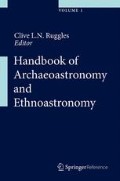Abstract
Space, time, and cosmos are concepts so fundamental and familiar to the Western world that they are often taken as universal. Time and space are regarded as entities in themselves that exist independently of the rest of reality, “dimensions” that are empty or neutral. Accordingly, Western societies treat them as resources or commodities. However, the assumption that space and time exist and are real is not universal to humankind.
Access this chapter
Tax calculation will be finalised at checkout
Purchases are for personal use only
References
Aveni AF (2001) Skywatchers: a revised and updated version of skywatchers of ancient Mexico. University of Texas Press, Austin
Barth F (1995) Cosmologies in the making. Cambridge University Press, Cambridge
Bourdieu P (1977) Outline of a theory of practice. Cambridge University Press, Cambridge
Bourdieu P (1991) El sentido práctico. Taurus, Madrid
Bourdieu P (1998) La Distinción. Criterio y bases sociales del gusto. Taurus, Madrid
Brague R (2003) The wisdom of the world. The University of Chicago Press, Chicago
Broda J (1993) Astronomical knowledge, calendrics and sacred geography in ancient Mesoamerica. In: Ruggles CLN, Saunders NJ (eds) Astronomies and cultures. University of Colorado Press, Niwot, pp 253–295
Brown CH (1983) Where do cardinal direction terms come from? Anthropological Linguistics 25(2):121–161
Condon RG, Scaglion R (1982) The ecology of human birth seasonality. Hum Ecol 10(4):495–511
Dershowitz N, Reingold EM (2008) Calendrical calculations, 3rd edn. Cambridge University Press, Cambridge
Eliade M (1959) The sacred and profane. Harcourt, Orlando
Galinier J (1999) L’entendement mésoaméricain: categories et objets du monde. L’homme 151:101–122
Giddens A (1995) La constitución de la sociedad. Bases para la Teoría de la Estructuración. Amorrortu, Buenos Aires
Griffioen S (1989) The worldview approach to social theory: hazards and benefits. In: Marshall PA, Griffioen S, Mouw RJ (eds) Stained glass: worldviews and social science. University Press of America, Lanham, pp 81–117
Habermas J (2006) Teoría de la acción comunicativa, II, 2nd edn. Taurus, Madrid
Hallpike CR (1979) The foundations of primitive thought. Clarendon, Oxford
Ingold T (2000) The perception of the environment: essays in livelihood, dwelling and skill. Routledge, London/New York
Itéanu A (1999) Synchronisations among the Orokaiva. Social Anthropology 7(3):265–278
Iwaniszewski S (1989) Exploring some anthropological theoretical foundations for archaeoastronomy. In: Aveni AF (ed) World archaeoastronomy. Cambridge University Press, Cambridge, pp 269–290
Iwaniszewski S (1993) Some social correlates of directional symbolism. In: Ruggles CLN (ed) Archaeoastronomy in the 1990s. Group D Publications, Loughborough, pp 45–56
Iwaniszewski S (2001) Time and space in social systems – further issues for theoretical archaeoastronomy. In: Ruggles CLN, Prendergast F, Ray T (eds) Astronomy, cosmology and landscape. Ocarina Books, Bognor Regis, pp 1–7
Kearney M (1995) World view. Chandler and Sharp, Novato
Kroeber A L (1925) Handbook of the Indians of California. [Bureau of American Ethnology Bulletin 78]. Smithsonian Institution, Washington
Leach E (1976) Culture and communication: the logic by which symbols are connected. Cambridge University Press, Cambridge
Lévi-Strauss C (1979) Antropología structural. Siglo XXI Editores, México
Lévi-Strauss C (2005a) Mitológicas I. Lo crudo y lo cocido. Fondo de Cultura Económica, México
Lévi-Strauss C (2005b) Mitológicas II. De la miela las cenizas. Fondo ce Cultura Económica, México
Meeus J, Savoie D (1992) The history of the tropical year. Journal of the British Astronomical Association 102(1):40–42
Milbrath S (1999) Star Gods of the Maya: astronomy in art, folklore, and calendars. University of Texas Press, Austin
Nilsson MP (1920) Primitive time-reckoning. C W K Gleerup, Lund
Olthuis JH (1989) On Worldviews. In: Marshall PA, Griffioen S, Mouw RJ (eds) Stained glass: worldviews and social science. University Press of America, Lanham/London, pp 26–40
Parker Pearson M, Richards C (1994) Ordering the world: perceptions of architecture, space and time. In: Parker Pearson M, Richards C (eds) Architecture and order. Approaches to social space. Routledge, London, pp 1–37
Popper KR (1972) Objective knowledge. The Clarendon Press, Oxford
Redfield R (1952) The primitive world view. Proceedings of the American Philosophical Society 96(1):30–36
Renfrew C, Bahn P (1991) Archaeology: theories, methods and practice. Thames & Hudson, London
Richards EG (1998) Mapping time: the calendar and its history. Oxford University Press, Oxford
Rochberg-Halton F (1984) New evidence for the history of astrology. Journal of Near Eastern Studies 43(2):115–140
Schutz A, Luckmann T (2003) Las estructuras del mundo de la vida. Amorrortu, Buenos Aires
Shanks M, Tilley C (1988) Social theory and archaeology. University of New Mexico Press, Albuquerque
Šprajc I (2001) Orientaciones astronomicas en la arquitectura prehispánica del centro de México, [Colección Cientítica, 427]. Instituto Nacional de Antropología e Historia, México
Šprajc I (2005) More on Mesoamerican cosmology and city plans. Latin American Antiquity 16(2):209–216
Tuan YF (1978) Space, time, place: a humanistic frame. In: Carlstein T, Parkes D, Thrift N (eds) Timing space and spacing time. Vil. 1: Making sense of time. Edward Arnols, London, pp 7–15
Tucci G (1974) Teoría y práctica del mándala. Barral editores, Barcelona
Wheatley P (1971) The pivot of the four quarters. A preliminary enquiry into the origins and character of the ancient Chinese city. Aldine, Chicago
Yates F (1966) The art of memory. Routledge and Kegan, London
Author information
Authors and Affiliations
Corresponding author
Editor information
Editors and Affiliations
Rights and permissions
Copyright information
© 2015 Springer Science+Business Media New York
About this entry
Cite this entry
Iwaniszewski, S. (2015). Concepts of Space, Time, and the Cosmos. In: Ruggles, C. (eds) Handbook of Archaeoastronomy and Ethnoastronomy. Springer, New York, NY. https://doi.org/10.1007/978-1-4614-6141-8_2
Download citation
DOI: https://doi.org/10.1007/978-1-4614-6141-8_2
Published:
Publisher Name: Springer, New York, NY
Print ISBN: 978-1-4614-6140-1
Online ISBN: 978-1-4614-6141-8
eBook Packages: Physics and AstronomyReference Module Physical and Materials ScienceReference Module Chemistry, Materials and Physics

